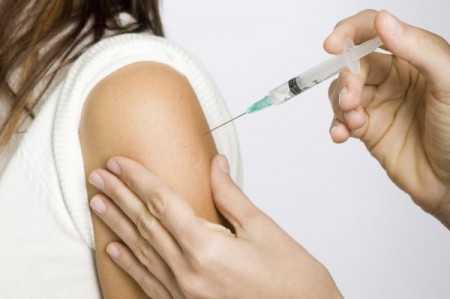 Just over half of girls have received the HPV vaccination, but a new CDC study shows it has significantly reduced prevalence of the cancer-causing STI among females who have received the vaccine when compared with those who have not. Photo by Adam Gregor/Shutterstock
Just over half of girls have received the HPV vaccination, but a new CDC study shows it has significantly reduced prevalence of the cancer-causing STI among females who have received the vaccine when compared with those who have not. Photo by Adam Gregor/Shutterstock
WASHINGTON, Feb. 22 (UPI) — The prevalence of human papillomavirus infection among teenage and young adult women is down nearly two-thirds since the U.S. Centers for Disease Control and Prevention started recommending vaccine in 2006, according to a new study.
The study is the first to show a drop in prevalence among women in their 20s, and continues to show decreases seen in smaller studies during the last few years, but researchers say the effect could be much stronger.
The vaccine is recommended by the CDC and other organizations for girls and boys starting at age 11, experts say, in order to protect children from HPV before they become sexually active and can become infected.
Concerns that the vaccine would influence teens’ sexual practices have also been unfounded, as research has shown the vaccine does not make children more likely to engage in risky sexual behavior, based on a the lack of an increase in other STI incidence among vaccinated girls.
“It’s just like putting on your seatbelt before turning on the car,” Dr. Alix Casler, medical director of pediatrics for Orlando Health, told UPI. She suggests separating the adolescents’ eventual discovery of sex from the effort to prevent life-threatening diseases.
Recommendations for the HPV vaccine — Cervarix, Gardasil and Gardasil 9 — have been expanded to boys, because of the wide range of cancers for which HPV increases risk, including cervical, anal, head and neck cancer, though a 2015 study showed vaccination rates remain relatively low, with just 57 percent of eligible girls and 35 percent of boys vaccinated.
“We are continuing to see decreases in the HPV types that are targeted by the vaccine,” Dr. Lauri Markowitz, a medical epidemiologist at the CDC, told CBS News. “We have seen declines in genital warts [caused by HPV] already. The next thing we expect to see is a decline in pre-cancers, then later on declines in cancer.”
For the study, published in the journal Pediatrics, used survey information collected as part of the National Health and Nutrition Examination Survey between 2003 and 2006 and between 2009 and 2012 on females between the ages of 14 and 34.
The researchers compared prevalence of HPV between the pre-vaccine group before 2006 and post-vaccine group after the vaccine was introduced, finding HPV prevalence declined by 64 percent, from 11.5 percent to 4.3 percent, in girls between age 14 and 19, and by 34 percent, from 18.5 percent to 12.1 percent, among women age 20 to 24.
Among women aged 14 to 24, the prevalence of HPV among vaccinated women, at 2.1 percent, was also significantly lower than the 16.9 percent of unvaccinated women with the STI.
The research is based on the 4vHPV vaccine, which protects against the four most common forms, though the 9vHPV vaccine was approved by the FDA for use to prevent more forms of HPV.
Casler said data in the next several years is likely to show continuing decreases in HPV prevalence as more adolescents receive the vaccine, however some pediatricians are hesitant because of personal bias. Many parents also are nervous the vaccine will act as a message to teens that sex is OK, making some parents want to delay vaccination until their adolescents are sexually active — by which time it may be too late.
“The infection is sexually transmitted, but that doesn’t need to be part of the conversation,” Dr. Joseph A. Bocchini, a pediatric infectious disease specialist at Louisiana State University, told the New York Times. “If a parent is concerned, physicians should be prepared to talk about it. But we don’t really discuss how people become infected with every vaccine-preventable disease.”
*This news story was resourced by the Oral Cancer Foundation, and vetted for appropriateness and accuracy.

Leave A Comment
You must be logged in to post a comment.